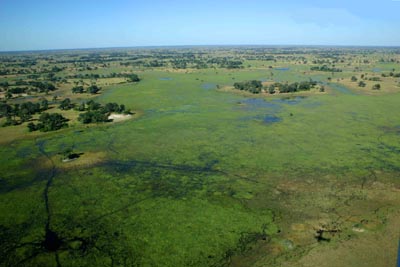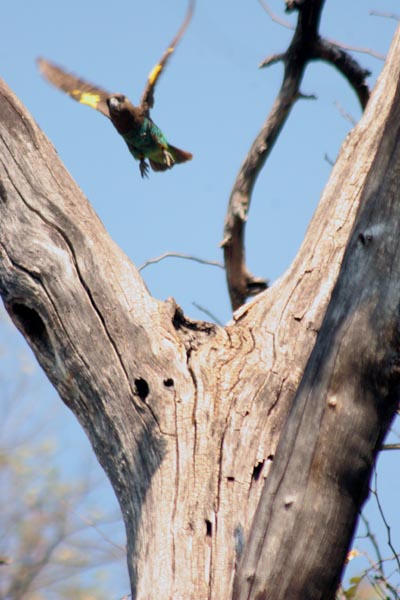Over the past two weeks I have been going through my Meyer's Parrot flocking and roosting behaviour data sets for 2004-2007 in the Okavango Delta, Botswana, as part of my thesis write-up. I have found this investigation to be an interesting journey into the possible ways in which these parrots could think about and perceive their natural environment. It is clear that they can navigate by the fact that during the breeding season males range far and wide in search of larval tree parasites, flying over floodplains, umpteen forest galleries, grasslands, winding channels, and papyrus swamp, and yet manage to find one hole in one specific tree in a forest of many trees. The biggest hill you can expect to find in the Okavango Delta is 2m, and therefore, from the air there are no reference points, beyond termite mounds and dead trees, a perfectly flat blue and green mosaic from the air. From top to bottom, the Okavango Delta is approximately 250 kilometres long, over which distance there is only a 60m change in altitude. Meyer's Parrots navigate effectively through this mosaic, and are therefore, likely familiar with the spatial distribution of food resources in their established feeding territory.

Photo of study area - Vundumtiki Paradise
In summer, the Meyer's Parrots utilize primary communal roosts, usually containing 6 - 10 parrots. These parrots leave the roost about one hour after sunrise to catch the warm morning sunshine. They sun themselves for 30 minutes, maintaining pairs or small groups, likely family units, of three or four. These sub-units then disperse into a patchwork mosaic of eleven different forest habitat types. During the mid-morning the Meyer's Parrot undertake most of their feeding, and as the morning progresses begin to aggregate through lingual feeding. Lingual feeding can be obligate or facultative, but involves constantly vocalizing during feeding activity. Meyer's Parrots are obligate lingual feeders, and based on mobility they have a high probability of encountering or hearing each other. By midday small groups of between three and six have come together to utilize secondary communal roosts. These small roosting flocks then disperse for feeding in the mid-afternoon, again aggregating towards the end of the day to form activity centres adjacent to roost trees. At activity centres the parrots preen and allo-preen within their family units or pairs exclusively. Towards sunset they vocalize synchronously and assemble in a neat row in the crook of Leadwood or African Mangostene. In winter, most Meyer's Parrots use nest cavities and natural hollows to roost, but this also the breeding season, during which approximately half of the population engage in the breeding effort.
Central to my study was to more fully understand the mechanisms behind flocking and roosting. Why Meyer's Parrots fly long distances and use complex vocalizations to aggregate and roost at a seemingly central point? What are the primary benefits? When and why do Meyer's Parrots flock on certain food items? Some researchers put forward that species that utilize communal roosts are likely doing so to benefit from information sharing about food resources during periods of resource scarcity. Reduced risk of predation by improving detection of predators and diluting risk of capture are simply byproducts of this information-sharing. My study and several others on African and Australian parrots suggest, however, that these parrots don't use communal roosts as information centres, but rather use them to facilitate dispersal from a central point. My study also shows that this central point is constantly moving according to shifts in food resource abundance and distribution. Therefore, in order to stay with the roosting community Meyer's parrots have to repeat the daily activity cycle described above throughout summer. As indicated previously, family units of the breeding pair and one or two of their progeny have been observed together for up to a year, until the breeding pair nests again. Over this period is it not feasible that the offspring, while foraging with the parents, learn the lay of the land, and thus where all the seasonal food resources can be found, and all the tricks they will need to know to be effective in this, their natural habitat. For example, fledglings from the previous breeding season have been observed to assist in provisioning the female during the egg-laying period. The male likely uses this period to teach his offspring where to find and how to utilize larval tree parasites that are keystone in the breeding effort. After this period, these sub-adults are chased away from the nest cavity. I would like to put forward that Meyer's Parrot communal roosts are central to the social and spatial organization of Meyer's Parrot populations, resulting in a cellular population structure with lots of overlap between feeding territories. This structure has distinct social and cultural benefits, adapting the members of a roost to the specific requirements of the area within which they forage. The maintenance of genetic diversity is likely facilitated by extra-pair copulations and high mortality.
To what extent is information shared at the communal roost? I don't know, but it is probably communicated passively, whereby the roost subtly moves to the area with the highest food resource abundance, established by aggregation during the day through lingual feeding. Basically, the location of the communal roost is constantly moving towards food resources. In my study Meyer's Parrots used a specific communal roost for no more than a few days before it had to move. Similar to musical chairs, throughout the day the parrots wander in search of food, aggregate somewhat by midday and then as the sun sets rush to find a new or established communal roost site. They are not too selective, as all they require is the crook in large closed canopy of an African Magostene, African Ebony, Mopane, Knobthorn or Leadwood tree. All of these are in abundance, and thus, again, the most important unit the family or community associations. Roosting flocks were seldom larger than 12 parrots, and thus could very well be several generations. Another indicator of inter-generational continuity is the evident use of certain nest cavities for over one hundred years. This was determined by assessing the age of dead Leadwood tree in which the Meyer's Parrots were nesting. One of these nest cavities was in a petrified Leadwood tree, but at the entrance there was evidence of excavation characteristic of Meyer's Parrots (i.e. lines radiating from the entrance hole). These excavations had to have taken place prior to petrification. In addition, the lower lip of the entrance has been smoothed by generations of parrots entering the nest cavity.
For more information regarding these findings and other from the Meyer's Parrot Project in the Okavango Delta, Botswana, please contact Steve Boyes at [email protected]. I also have .pdf's of the nine magazine articles that I have published on the project. Peer-reviewed scientific papers will become available later in the year, after the completion of my PhD thesis. If you would like to contribute towards the project please use the following link to donate through the World Parrot Trust - just scroll down to Meyer's Parrot.
To donate from the US: click here >>
To donate from anywhere else: click here >>
This something I have been meaning to share, but seemed to slip through the works. This is a photo of that glorious moment from for any parrot researcher, the first flight from the nest cavity, the moment of fledging!

Photo of parrot fledging at Vundumtiki, Okavango Delta, Botswana
































